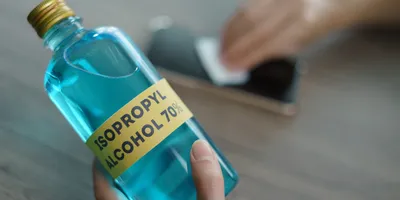What Is Isopropyl Alcohol (IPA)?
Isopropyl alcohol (C₃H₈O), also known as IPA, isopropanol, or 2-propanol, is a clear, colorless, flammable liquid with a slightly sweet odor. It is widely used in industrial, pharmaceutical, and laboratory environments due to its solvent properties, disinfectant capabilities, and volatility.
It serves as an intermediate in the manufacture of chemicals such as acetone, glycerol, and isopropyl acetate, and is a powerful solvent for oils, resins, gums, and alkaloids. Isopropyl alcohol is also utilized as a deicing agent, preservative, extraction solvent, and drying agent in numerous applications.
Is Isopropyl Alcohol the Same as Rubbing Alcohol?
Although often used interchangeably, isopropyl alcohol and rubbing alcohol are not exactly the same. Rubbing alcohol typically refers to a solution of 70% isopropyl alcohol and 30% water or other denaturants. This dilution is optimized for disinfection and skin contact, making it safer for medical and household use.
Pure isopropyl alcohol (90% or greater) evaporates more quickly and is more effective as a solvent, but it can be harsh on the skin and may not kill all pathogens due to rapid evaporation.
Key Differences:
| Property | Isopropyl Alcohol (99%) | Rubbing Alcohol (70%) |
|---|
| Concentration | 99% IPA | 70% IPA + water/denaturants |
| Use Case | Industrial/lab cleaning | Antiseptic/disinfection |
| Skin Compatibility | Can be drying | Gentler on skin |
Does Isopropyl Alcohol Expire Over Time?
Yes, isopropyl alcohol can expire, although it has a relatively long shelf life when stored properly. Over time, evaporation can reduce the concentration, especially if the container is not sealed tightly. Light and heat exposure may also degrade the chemical, affecting its effectiveness.
Storage Tips to Extend Shelf Life:
- Store in a cool, dry, well-ventilated area
- Use a tightly sealed container
- Keep away from heat, flames, and direct sunlight
- Check expiration dates and labels
Common Uses of Isopropyl Alcohol in Industry and Labs
Isopropyl alcohol is incredibly versatile. Its key applications include:
- Solvent: For essential oils, resins, alkaloids, and adhesives
- Disinfectant: Used in hand sanitizers, medical swabs, and surface cleaners
- Deicing agent: Applied in aviation and fuel handling
- Preservative: In cosmetics and pharmaceuticals
- Laboratory reagent: For DNA precipitation, slide cleaning, and surface sterilization
Isopropyl Alcohol Hazards, Exposure, and First Aid
Isopropyl alcohol is flammable and volatile. Exposure can occur through inhalation, skin contact, eye contact, or ingestion. Here's how to handle exposure safely:
Inhalation
- Move to fresh air immediately
- Seek medical help if coughing, wheezing, or chest discomfort develops
Skin Contact
- Rinse affected area thoroughly with water and soap
- Remove contaminated clothing
- Contact a physician if irritation persists
Eye Contact
- Remove contact lenses if present
- Flush eyes with water or saline for 20–30 minutes
- Call a poison control center or seek hospital attention
Ingestion
- Do not induce vomiting
- If conscious, offer 1–2 glasses of water to dilute
- Call poison control or emergency services immediately
Safe Handling and Storage of Isopropyl Alcohol
To minimize risk:
- Store in a flammable safety cabinet
- Keep away from sparks, flames, and oxidizers such as chlorine, acids, and isocyanates
- Use in well-ventilated areas to avoid vapor accumulation
Personal Protective Equipment (PPE) for Isopropyl Alcohol Safety
Clothing
- Wear chemical-resistant clothing
- Use nitrile or Silvershield gloves for prolonged handling
Eye Protection
- Use indirect vented splash goggles
- Ensure eye wash stations are within 10 seconds of work area
Respiratory Protection
- Employ NIOSH-approved respirators for IPA
- Follow OSHA’s 29 CFR 1910.134 for respirator use
- For high exposure or unknown concentrations, use a supplied air respirator or SCBA
Final Thoughts on Isopropyl Alcohol Safety, Storage, and Usage
Isopropyl alcohol is a widely used and essential chemical in industrial, medical, and research settings. While highly effective as a solvent and disinfectant, its flammability and potential health effects require careful handling and storage. Understanding the distinctions between isopropyl and rubbing alcohol, along with proper safety protocols, helps ensure both effectiveness and safety in everyday applications.
Frequently Asked Questions (FAQ)
Is isopropyl alcohol the same as rubbing alcohol?
No, rubbing alcohol is a diluted solution (usually 70%) of isopropyl alcohol and water or other ingredients, designed for topical use.
Can isopropyl alcohol expire?
Yes, over time it can evaporate or degrade, especially if exposed to air, light, or heat. Always check the expiration date and storage conditions.
What are the risks of inhaling isopropyl alcohol?
Inhalation can cause respiratory irritation, dizziness, or more severe symptoms with high exposure. Work in well-ventilated areas and use appropriate PPE.
What should I do if isopropyl alcohol gets in my eyes?
Flush with clean water for 20–30 minutes and seek immediate medical attention. Do not apply ointments or medications without professional guidance.











